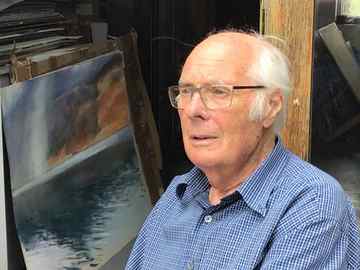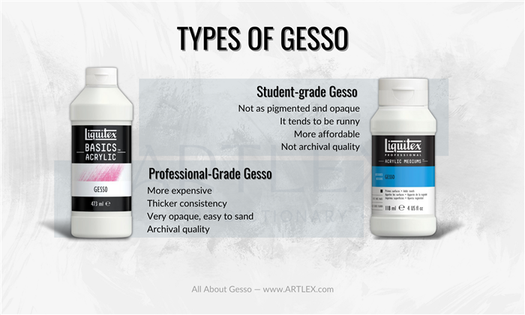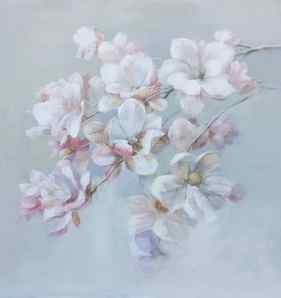Landscape photography has allowed me to travel, explore the outdoors and appreciate the beauty in our natural world. Capture moments in images that evoke emotion and inspire.
A master of landscape painting
NEW EXHIBITION: DONALD WILKINSON
One of the north’s greatest living landscape painters will feature in a new exhibition in Grasmere in September.
Works by Donald Wilkinson will be on show at the archive gallery at the Heaton Cooper Studio.
Donald Wilkinson was born in Keswick and studied at Carlisle College of Art from 1953-1957 and then at the Royal College of Art, 1959-62, where he was awarded the Andrew J. Lloyd scholarship for Landscape. His work mainly focuses the landscape of the Lake District, and is noted for light effects achieved in the atmospheric landscapes.

He says that he has been looking at and drawing landscapes for as long as he can remember. “All the work in this exhibition is about the Cumbrian landscape – the fells here in the Lakes or the Solway coastline. Both are places I have known all my life. I spend a great deal of time working in the landscape, often returning to the same location over a period of time to watch the changes that the weather and the season have on a particular place.”

Wilkinson says that his early memories are of being taken for walks among the fells or having picnics by the beck in the Mosedale Valley, below Carrock Fell. “This still remains a special place for me where I continue to return to draw. I tend to work in the autumn, winter or early spring and like to find somewhere I can tuck myself away so that I can concentrate on the drawing without being distracted.
“When I begin working in a chosen landscape, I spend time looking, trying to really understand the essence of the place. I make drawings in sketchbooks as I move through the landscape as well as taking photographs and working on larger drawings on location. I work very quickly because for me the important thing is to express the elusiveness of the light either on the land or the water.
“I often make a series of large drawings in the landscape in one session as well as the briefer sketchbook studies. These are sometimes in colour using pastels or watercolours and sometimes in charcoal. Once I am back in the studio, I spread out the results and away from the landscape I will assess the works in their own right.”

For many years Wilkinson worked as a printmaker focusing on making etchings. “I still enjoy the experience of printmaking and some of the works in this exhibition are a combination of monoprint and pastel. I enjoy the directness of the medium, making marks using cotton rag, ends of brushes or fingers before printing on to large sheets of paper. Each one is unique and I enjoy responding to the unexpected happenings integral to printmaking using pastels.”
The exhibition is curated by fellow artist Julian Cooper who said: “Donald Wilkinson is now 84 but doing his best work ever, in my opinion. This is going to be a very important show.”
The exhibition opens on Thursday Sept 16 and runs until the end of November.
Here are tributes from noted artists and poets:
What Donald Wilkinson’s skies and many of my own poems have in common is a vision of what I would describe as an epiphanic experience of the natural world, which in itself has something in common with that of William and Dorothy Wordsworth, themselves natives of those same hills and dales in their ever-changing light.
Kathleen Raine, Poet. Forward to catalogue, A Wider Landscape, Wordsworth Trust
I can think of no contemporary artist as observant of the weather, in whom it creates such rapt attention, and whose technical resources are as well adapted to the recreation of its moods.
The landscapes are the underlying timeless element in his pictures but the season in which they are seen and the weather conditions which may be changing with speed are what his paintings record. Whilst it’s crucial to attend to the media that Wilkinson employs and to how he works with them, there is also a danger of distraction in overstressing his technical means. His pictures are a way of keeping close to and entering into the quick of the moment.
He doesn’t go in for what Hopkins in poetry called the Parnassian. There’s an invigorating riskiness in his work, a sense of the artist pitched moment by moment against the fugitive effects of light and colour, seen through wind and light and rain, in momentary calm and sudden turbulence.
Jamie McKendrick, essay for catalogue, A Wider Landscape, Wordsworth Trust
Places, and his relationship with them, are of the utmost significance to Wilkinson. One feels he knows them like the back of his hand or the soles of his walking boots. Yet he is not a “topographical” artist, a kind of illustrator of various visited and explored landmarks, an artist-tourist. His sense of significant place goes deeper. It is in his roots. It is highly individual…………
His places hold all kinds of personal memories. In his drawings, however, they have also become places of imagination, regardless of precise definitions of geography or locale. They have a universal meaning to anyone who relishes rocks, waves, snow, sunset, storm clouds, even the bleakness of wild land. And anyone who relishes the scudding, sliding, percussive, slashing, wandering marks on paper that are this painter’s syntax and language. This is where invention and memory as well as observation are involved.
Christopher Andreae, Introduction to Stains of Light catalogue, Tullie House Art Gallery
Most recently, I was fortunate to observe him in action on board the ‘Glen Massan ‘, an Irish fishing boat converted into an ideal vessel for artists wishing to depict the poetic nature of Scotland’s Highland and Islands. We were sailing, along with six other artists, from the Cowal Peninsula towards Arran. He was drawing with charcoal and pastel and totally at ease with the turbulent weather, drawing in perfect harmony and with the currents of sea and air and capturing the elemental forces of nature. He stood balanced and wedded to the boat riding the storm-tossed waters.
Prof. Richard Demarco, Introduction to Solway Shoreline Exhibition
Why is storytelling important in landscape photography?
Stories and storytelling have been part of all human cultures for thousands and thousands of years. Through stories, we share messages and knowledge and portray emotion and feeling. With impactful stories, you can influence and inspire others. However, a story is only as strong as the way it’s told. Developing your storytelling skills through still images will help you elevate the story you’re sharing and enhance your landscape photos.
A story is essentially about the characters, their interactions, and the events that occur. For a landscape story, the characters are the subjects and elements in a scene. Interactions between elements make a more engaging story.

Events like sunsets, sunrises, and weather conditions like rain and storms can provide unique light and opportunities to capture a better story. Storytelling is the approach you take to share the story you found within the landscape. Storytelling defines how the story (scene) is introduced and the journey the viewer is guided on through the landscape. The emotion shared through a story is embellished through how the story is told. The storytelling strongly influences what the audience focuses on in the story.
Related Reading: Discovering an engaging story of the landscape is just as important as the approach you take to storytelling. Learn more about How to Find a Landscape Story to Create Captivating Photos.
Take, for example, a joke told by someone skilled at telling jokes. Their tone, expression, the voices they use and the small details they add all contribute to the delivery and result in raucous laughter from the audience. Now imagine the same joke told by someone who is not experienced or as confident to the audience on a comedic journey. The punch line is the same, but the joke doesn’t have the same effect. The same is true for storytelling in landscape photography. Two photographers can photograph the same scene, resulting in two different images. The story (landscape) is the same, but the storytelling of one takes the audience on a journey and delivers the story with greater impact. How the viewer is surprised, captivated or inspired by a landscape photo is partly to do with the story but significantly affected by how that story is presented through the photographer’s storytelling skills.
How Composition Impacts the Story and Storytelling
You may have noticed that I explained what a story and storytelling are in the previous section using many terms related to composition. This is because the decisions you make around composition often determine the story you capture and how you tell that story.

Deciding on what’s included in your frame will essentially define your story. What you include and how you compose your image’s foreground is likely how the audience is introduced to the scene. The rest of the composition influences how the viewer is guided through your photo.
Related Reading: Composition dramatically impacts how the features of a landscape are presented, enhanced and brought to the audience’s attention, as well as the emotion portrayed through an image. Learn more about how to Harness the Power of Composition in Landscape Photography.
While composition can significantly affect the storytelling in an image, it’s essential to think about storytelling when you are discovering, composing, capturing and editing your landscape image.
How do you tell a story in landscape photography?
Now we know how important storytelling is to capturing impactful images, here are some tips to help you improve your storytelling skills.
1. Think About the Viewer
It’s critical that when you are exploring a location for a story and deciding on how you will tell that narrative, you have your intended audience in mind. If the viewer has never seen the landscape, they’ll be unfamiliar with the features or what makes the location unique. Through the story, it’s your task to remedy this. For broader appeal, assume your audience is unfamiliar with the location. Think about what you want to tell them about the landscape.

Introduce your scene with a strong foreground or focus area that grabs the viewer’s attention. Guide the viewer’s eye through the scene and help them understand what they are looking at. The more prominent you make the story, the more powerful the image will be – this is why simple scenes work so well. If you are just shooting for yourself, this still works. You are the intended viewer – no one else! However, if you want your image to captivate a wider audience, the points raised here are vital to capture an impactful photo.
2. Identify the Main Subject
Every story has a payoff. In most landscapes, the payoff is the main subject. This is where you intend the viewer’s eye to land at some stage when they explore your image. The main subject can be a prominent feature in the scene, like a waterfall, mountain or a solo tree.

Other elements should support or complement the main subject, ensuring they don’t compete for attention and distract the viewer. Ensure you give your main subject space in your photo, in the center or slightly to the left or right – avoid positioning it near the edge of the frame. You can draw the viewer’s eye to the main subject using light to highlight it, making it more prominent than the rest of the landscape or leading the eye toward that area using natural lines (LINK).
3. Create the Lead-up to the Main Subject
Landscape photos are more engaging if the viewer’s eye is moved in some way around the scene. This encourages the audience to explore and discover more elements within the scene. So, think about the journey you want to guide the viewer along. The payoff within a story is where you want the audience to finish their journey. A strong foreground and leading lines effectively introduce the scene and can then direct the viewer’s eye through the image to the main subject.

Alternatively, the main subject may be so prominent that it’s likely the first thing that catches the viewer’s eye. You can still other elements within the scene that the audience can explore, which extends or enriches the story. Supporting elements help inform the viewer about the broader landscape, providing context for the main subject.
4. Think About the Action in Your Scene
A still image captures just a moment, typically from a split second to a few seconds long. But a lot can happen in this short moment that can add to the story. Identify the action that is taking place within the scene.

From water flowing down a river or falling down a waterfall to wind moving through the trees or waves crashing against the beach rocks. These interactions add a new dimension to the story, increasing the interest and introducing a different energy to the photo. Consider how the audience will portray this action, how best to capture it, and where it should be positioned in the frame.
Related Reading: Shutter Speed will dramatically impact how any action is captured in a photo. Learn about the Optimal Shutter Speeds for Creating Dynamic Seascapes.
An extended shutter speed of 1/4 a second to a few seconds will create motion blur from moving objects. Alternatively, the movement in a scene could be distracting, like leaves or grass being blown around. Select a shutter speed of 1/100 of a second or faster to freeze this action. In the end, you need to determine if any interaction in a scene adds to the story or weakens the narrative.
5. Use Storytelling to Enhance the Story
In addition to guiding the audience through the story, storytelling can enhance or embellish parts of the narrative. We’ve already covered one way this works: making the main subject more prominent to the viewer through its position in the frame or size related to the rest of the landscape. If there is a part of the scene that you want to make more prominent to the audience, bring it closer to the camera – or move the camera closer to the object. This is another demonstration of why foregrounds in landscape photos can be such a powerful technique. Another way to enhance a story is to minimize or remove distraction or detail that does not support the narrative. Looking for a simple landscape is an effective storytelling technique to create a strong story, as the scene has fewer elements to divert the audience’s attention.
6. Make an Impact on the Viewer
An engaging landscape photo impacts the viewer by creating a reaction or feeling within the viewer. Storytelling can assist in evoking a response from the audience in several ways. One approach is to share the feeling you experienced while standing in the scene with the viewer so they can relate to the landscape personally. Alternatively, you might portray an emotion that the viewer can imagine an element in the landscape might feel.

- Intrigue by including darker areas within the image or shadows, which adds a sense of mystery to part of the photo.
- Admiration is a typical response to strive for through sharing a stunning view or an aspect of the outdoors that prompts wonder and respect for the natural world.
- Curiosity by including geological or biological phenomena that create mesmerizing patterns and textures.
- Inspiration generates a response within the audience to the point that it results in some action, whether a change in behavior or to spark the drive within the viewer to pursue their own adventure.
7. Seek Out Smaller Stories
We’ve all been guilty of chasing the expansive views and vast vistas.
They are grand and impressive and hopefully result in an appealing landscape image.
However, many compelling landscape stories are found within smaller portions of the scene.

There are several advantages to capturing smaller stories of the landscape, like
- Littler scenes are more intimate, sharing a more personal view with a warm or friendly feeling.
- Smaller stories generally require the camera to be closer to a telephoto lens, which captures more of the finer detail within the features.
- Intimate scenes are simpler, so the captured story is strong with less distraction.



